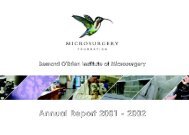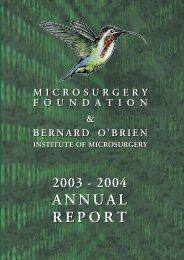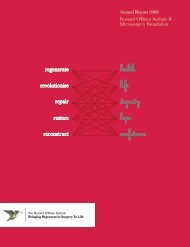annual report - O'Brien Institute
annual report - O'Brien Institute
annual report - O'Brien Institute
You also want an ePaper? Increase the reach of your titles
YUMPU automatically turns print PDFs into web optimized ePapers that Google loves.
Many other research topics are being investigated<br />
and they are detailed under the section headed<br />
“Scientific Research”. It has been a pleasure to be<br />
involved in the many projects with cross-links with<br />
more and more colleagues and other research<br />
institutes both in Australia and overseas. These<br />
collaborators have been very generous of their time<br />
and facilities and their institutes are acknowledged<br />
elsewhere in this <strong>report</strong>.<br />
Fellows<br />
Research Fellows from overseas and Australia,<br />
many doing postgraduate degrees, contribute to<br />
the research program and participate in clinical<br />
work at St. Vincent’s Hospital. Each undertakes<br />
a fellowship of one year or more and gains a<br />
fellowship certificate in hand and microsurgery.<br />
During the period of this <strong>report</strong> the following held<br />
appointments at the Bernard O’Brien <strong>Institute</strong> of<br />
Microsurgery:<br />
Oliver Cassell, Plastic Surgeon, United Kingdom -<br />
Tissue engineering models and matrix.<br />
Rob Donato, Plastic Surgeon, Australia -<br />
Extracorporeal circulation.<br />
Slobodan Djurickovic, Orthopedic Surgeon,<br />
Canada.<br />
Sunao Furuta, Plastic Surgeon, Japan -<br />
In vivo model of angiogenesis and role of nitric<br />
oxide.<br />
Hans Mark, Plastic Surgeon, Sweden -<br />
Model of bone non-union.<br />
Peter Meagher, Plastic Surgeon, Ireland -<br />
Tissue engineering - muscle generation in stem<br />
cells.<br />
David McCombe, Plastic Surgeon, Australia -<br />
Tendon healing.<br />
Kanit Sananpanich, Plastic Surgeon, Thailand -<br />
End-to-side nerve repair.<br />
These fellows are the lifeblood of the <strong>Institute</strong>.<br />
Not only do they learn microsurgery and partake in<br />
research programs, but they contribute enormously<br />
from an intellectual, cultural and social viewpoint.<br />
Since the <strong>Institute</strong> began more than 200 fellows<br />
from all corners of the globe have trained in<br />
research and in clinical microsurgery at St.<br />
Vincent’s Hospital. Many have returned to their<br />
home country to establish microsurgery centres<br />
and become leaders in their field.<br />
A highlight of the year was the appointment of Allan<br />
MacLeod, Head of Plastic Surgery at St. Vincent’s<br />
Hospital and a Director of the Microsurgery<br />
Foundation, as Associate Professor, acknowledging<br />
his major contributions in clinical and research<br />
plastic and microsurgery. This is a great honour and<br />
we congratulate Allan on his achievement.<br />
Alumni<br />
A large alumni group now exists as a consequence<br />
of the large international fellowship that has<br />
developed through training at the <strong>Institute</strong>. Many<br />
fellows have become lifelong friends with their<br />
Australian colleagues and also with those who<br />
trained with them from other parts of the world.<br />
It is very gratifying, when attending international<br />
meetings to meet up again with so many colleagues<br />
and recount tales, tall or true, of their experience at<br />
St. Vincent’s and the <strong>Institute</strong> and on a personal<br />
note, how enjoyable it is to be made so welcome on<br />
visiting these fellows in their own countries. The<br />
hospitality has been extraordinary and I consider it<br />
a great privilege to have been able to share in their<br />
development and interests. This year I was<br />
particularly privileged to meet many of our alumni<br />
at the Asian Pacific Federation of Societies for<br />
Surgery of the Hand meeting in Madras and at<br />
the South African Society for Surgery of the Hand.<br />
Our friend and colleague Julian Pribaz, Professor of<br />
Plastic Surgery at Brigham and Women’s Hospital,<br />
Harvard, Boston, was appointed the B.K. Rank<br />
Travelling Professor for the Annual Scientific<br />
Meeting of the Royal Australasian College of<br />
Surgeons in Melbourne in May. Julian trained in<br />
plastic surgery at St. Vincent’s and was a member of<br />
our plastic surgery team before moving to Boston.<br />
We were inspired by his clinical and research<br />
presentations.<br />
Acknowledgements<br />
The Board of Directors of the Microsurgery<br />
Foundation under the Chairmanship of Mr Ronald<br />
Walker have been again instrumental in financing<br />
our research efforts. They give generously of their<br />
time and expertise and it is impossible to under<br />
estimate their contributions.<br />
Alan Skurrie, past Chairman of Microsurgery<br />
Foundation and long term member of the Board<br />
retired this year. It is with great regret that we say<br />
goodbye to Alan who over many years has been a<br />
tower of strength, especially through the lean years<br />
when with perseverance, wisdom and charm he<br />
enabled us to gain many major grants which<br />
The Jack Brockhoff Nerve and Muscle<br />
Laboratory<br />
The Jack Brockhoff Laboratory is dedicated to<br />
researching the mechanisms by which injured nerves<br />
and muscles regenerate and to identifying chemical<br />
factors and various administration protocols which<br />
enhance the repair process.<br />
Senior Scientists: Aurora Messina, Bruce Dowsing<br />
Clinical Research Fellow: Tim Bennett.<br />
Members of Laboratory: Richard Brouwer, Carl<br />
Byers, Rob Donato, Ruitong Fan, Sachiko Maeda,<br />
Marian Todaro, Rosalind Romeo, Kanit Sananpanich,<br />
Tim Shakespeare, and Wayne Morrison.<br />
…and Major Collaborators:<br />
Lawrie Austin 1 , Alan Hayes 2 , Nic Nicola 3 , Mary<br />
Galea 4 , Dr. Paul Patterson 5 , and Catherine Sangster 4 .<br />
1Melbourne Neuromuscular Research Centre, St.<br />
Vincent’s Hospital, Melbourne.<br />
2Department of Biological Sciences, Victoria<br />
University of Technology, Footscray, Vic.<br />
3Walter and Eliza Hall <strong>Institute</strong> for Medical Research,<br />
Melbourne.<br />
4School of Physiotherapy, University of Melbourne.<br />
5California <strong>Institute</strong> of Technology, USA.<br />
Nerve repair and regeneration<br />
Microsurgeons are often faced with the task of<br />
repairing injured nerves. Unless successfully repaired,<br />
nerve injuries lead to dysfunction of their target organs,<br />
resulting in permanent disability such as loss of muscle<br />
use (motor nerves), or loss of sensation to a limb<br />
(sensory nerves) or pain. On average nerve injuries<br />
occur in young adults and hence, failure to recover has<br />
a tremendous economic impact. Modern microsurgical<br />
techniques enable accurate repair of most nerves but<br />
the functional outcome is often poor, due to death of<br />
the nerve cells (neurons), inadequate regeneration of<br />
axons (nerve fibers), and/or deterioration and scarring<br />
of the target prior to reinnervation.<br />
Neurons growing axons and target organs depend on<br />
continuing input from each other and supporting cells<br />
for growth, maintenance and survival, without these<br />
they atrophy and/or die. These actions are mediated by<br />
chemical factors (proteins) known as growth factors.<br />
The recent discovery and the availability of various<br />
growth factors, such as leukemia inhibitory factor<br />
(LIF), have provided a means of treating regenerating<br />
nerves and their targets to improve recovery, with very<br />
encouraging results!<br />
MICROSURGERY<br />
FOUNDATION<br />
Entubulation repair of transected nerves is the<br />
standard model, used in our laboratory, for studying<br />
peripheral nerve regeneration and recovery. It<br />
involves removing a small length of nerve, thereby<br />
leaving a gap between the proximal and distal ends of<br />
the nerve. This gap is bridged by plugging these<br />
stumps into either end of a hollow silicone tube which<br />
spans the gap, thus forming a sealed chamber. Within<br />
this chamber, proteins (survival factors, etc.) and cells<br />
that collect in response to nerve injury can be studied,<br />
test substances can be administered and their effects<br />
on the nerve repair process determined.<br />
Hand and limb injuries often involve trauma to their<br />
supplying nerves and despite current surgical techniques<br />
the degree of function recovered is generally<br />
unsatisfactory. Our research aims to understand the<br />
mechanisms of regeneration of nerve and muscle<br />
following injury and to evaluate agents which may<br />
enhance the repair process.<br />
Improving Nerve Repair with neurotrophic<br />
factors<br />
Following nerve injury cells near to the trauma site<br />
produce various proteins, called growth factors, that<br />
encourage healing and nerve regeneration. The<br />
availability of some of these growth factors, such as<br />
leukemia inhibitory factor (LIF) and glial cell derived<br />
neurotrophic factor (GDNF), has enabled us to<br />
develop methods to administer these factors to the<br />
site of injury and to evaluate their efficacy as nerve<br />
regeneration promoters. We found that the repair of<br />
cut or crushed rat nerves in conjunction with either<br />
LIF or GDNF results in significantly enhanced nerve<br />
regeneration, the muscles they re-connect with do not<br />
waste as much, and eventually their function is<br />
significantly improved. However, addition of these<br />
factors together does not further enhance the recovery<br />
obtained with either factor alone.<br />
Before these promising factors can be used in the<br />
clinical setting, a relatively simple and cheap method<br />
of administering them at the time of surgery must be<br />
found. In collaboration with AMRAD Pty Ltd we are<br />
about to test a method to administer LIF to the site of<br />
nerve repair, and if successful we believe we will be<br />
ready to commence clinical trials.<br />
Expression of LIF following human nerve<br />
injury<br />
To date the expression profile of LIF within nerves<br />
has been confined to animal models such as rats and<br />
mice. We therefore determined whether LIF is<br />
expressed in normal human nerves and whether its<br />
16 25






